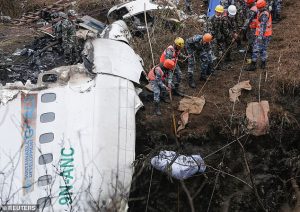In a devastating incident that has shocked the aviation community, a passenger plane crashed shortly after takeoff from Kathmandu’s Tribhuvan International Airport on Wednesday, July 24, 2024, resulting in 18 fatalities. The pilot miraculously survived the crash and is currently receiving medical treatment.

The ill-fated aircraft, operated by local carrier Saurya Airlines, was carrying 19 people, including two crew members and 17 technicians, when it veered off the runway and burst into flames during its attempted takeoff. The flight was bound for Pokhara, a popular tourist destination known for its picturesque landscapes and proximity to the Himalayas.
Eyewitnesses reported seeing the plane skid off the runway before catching fire. Television footage captured the harrowing scene as firefighters battled to extinguish the blaze, with thick black smoke billowing into the sky. The crash site, located on the eastern side of the airport, was quickly cordoned off as emergency responders and investigators rushed to the scene.
The sole survivor of this tragic incident, the pilot, was immediately transported to Kathmandu Medical College Hospital for treatment. According to medical staff, the pilot sustained injuries to the eyes but is not in critical condition. The identities of the deceased have not been released, but authorities confirmed that the passengers included 18 Nepali nationals, one of whom was a child, and one Yemeni citizen.
Nepal’s Civil Aviation Authority has launched an investigation into the cause of the crash. Preliminary reports suggest that the Bombardier CRJ200 aircraft, which was approximately 20 years old, experienced difficulties immediately after liftoff. Aviation experts are scrutinizing factors such as weather conditions, mechanical issues, and human error as potential contributors to the accident.
This tragic event has once again brought Nepal’s aviation safety record into the spotlight. The country has faced numerous challenges in maintaining air safety standards, particularly due to its mountainous terrain and rapidly changing weather conditions. In recent years, Nepal has witnessed several fatal air accidents, including a Yeti Airlines crash in January 2023 that claimed 72 lives, and a Bangladeshi aircraft crash in 2018 that resulted in 49 fatalities.
The international aviation community has expressed concern over Nepal’s air safety record, with some calling for stricter regulations and improved infrastructure. The country’s aviation sector has experienced significant growth in recent years, facilitating transportation to remote areas and supporting the tourism industry. However, this expansion has been marred by a series of tragic incidents.
Tribhuvan International Airport, Nepal’s primary aviation hub, was temporarily closed following the crash to allow for emergency operations and initial investigations. The airport’s location, nestled in a valley surrounded by mountains, presents unique challenges for pilots, particularly during takeoff and landing procedures.
As the investigation into this latest tragedy unfolds, questions are being raised about the maintenance practices and safety protocols of Nepalese airlines. Saurya Airlines, which operates domestic flights with two Bombardier CRJ-200 regional jets, will likely face intense scrutiny in the coming weeks.
The crash has sent shockwaves through Nepal’s close-knit aviation community and the families of those affected. As the nation mourns the loss of 18 lives, there are renewed calls for comprehensive reforms in the country’s aviation sector to prevent future tragedies.
In the wake of this disaster, the survival of the pilot stands as a testament to the unpredictable nature of aviation accidents. As investigators piece together the events leading up to the crash, the aviation industry will be watching closely, hoping to glean insights that could prevent similar incidents in the future.
As Nepal grapples with yet another aviation tragedy, the question remains: Will this be the catalyst for meaningful change in the country’s air safety practices? Only time will tell if this latest incident will lead to stricter regulations, improved training, and enhanced safety measures that could help prevent future loss of life.
In a twist of fate that defies the odds, the pilot’s survival in this Nepal plane crash serves as a stark reminder of the thin line between disaster and miraculous escape in the perilous world of mountain aviation.

